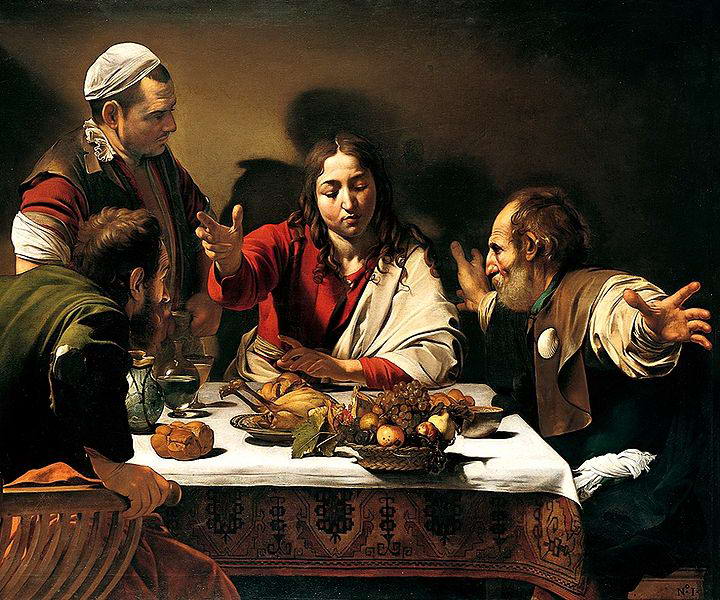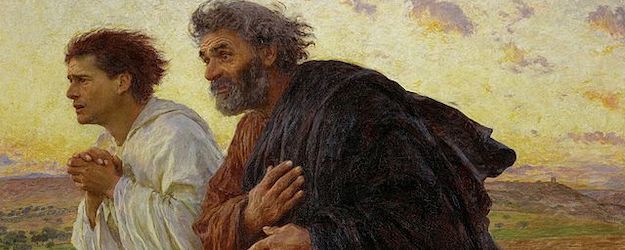33 That same hour they got up and returned to Jerusalem; and they found the eleven and their companions gathered together. 34 They were saying, “The Lord has risen indeed, and he has appeared to Simon!” 35 Then they told what had happened on the road, and how he had been made known to them in the breaking of the bread. [Luke 24:28-35, NRSV]
(L) Christ appears on the road to Emmaus, artist unknown; (M) Cena in Emmaus, Caravaggio, 1601; (R) Dashing back to Jerusalem.
Hospitality invites Christophany – the appearance and presence of Christ.
It is by being hospitable to a stranger that we get to see Jesus present.
Under Luke’s pen, the readers derive a distinct sense that the two disciples are someone endowed with hearts that can feel, heads that can be conscious of people in need, and hands that are ready to serve. In the story, as “the day is now far spent” (24:29), the disciples were conscious that the stranger was a traveler in need. The day nearly over, the stranger would need something to eat and a bed for the night. It matters not that the stranger is even someone who does not ask for your hospitality. Hospitality is something you will extend to him if your heart is in the right place and you are able, even without tremendous effort, to supply his needs. Luke’s narrative impresses on his readers that the hospitality and generosity expressed by the two disciples is the prelude to Christophany – the appearance and real presence of Christ.
The ending of a story, as we know, points to the beginning of a new story. So readers are well aware that the ending in the narratives of all the four Gospels are framed as a new beginning. They give ample hints that as their narrations of the life of Jesus of Nazareth draw to a close, all who would be disciples of Christ are poised for the start of a whole new phase of life and work.
Mark’s narrative could not end with the women “saying nothing to any one, for they were afraid” (Mark 16:8). “Saying nothing” could not possibly be the last word of the Good News of Jesus Christ who had already announced “the truth” at his anointing by a woman at Bethany that “wherever the gospel is preached in the whole world, what she has done will be told in memory of her” (Mark 14:9). The Lord was pointing to a future where the gospel is preached.
So too for Matthew, whose narrative ends in Jesus sending his disciples out on a mission, promising his presence and company “to the end of time” (Matthew 28:20), could only point to new chapters in a new mission phase of the Church the Lord left behind.
In John’s Gospel, readers are treated to a potent future-pointing picture captured in Jesus’ words. Peter asks Jesus about his assignment for John, and Jesus answers thus: “If it is my will that he remain until I come, what is that to you?” (John 21:23).
It is perhaps Luke’s narrative-end that most captures our imagination and detains us in serious reflection. For more than just future-looking, Luke’s Gospel on what has become classically known as the Emmaus Walk (Luke 24:13-35) portrays an unrepeatable moment which nevertheless would be the model for subsequent Christian experience. As the Resurrection event launched God’s renewed people in Israel two thousand years ago, so will it launch contemporary Christians of the twenty-first century, and of every subsequent century, on a path of authentic, kingdom-promoting life of discipleship.
Concerning this model, three elements in particular among other elements stand out for reflection. It is evidently the intention of the Risen Lord that in combination, these three elements set the pattern for the way he desired to be known and remembered from then on.
1. Breaking Open the Scriptures
The Risen Christ, yet unrecognized, pulled up alongside the two dispirited disciples. The first thing he did was to break open the Word of the Scriptures to them. The method and style of his exposition, and the substance of his analysis, caused their hearts to burn inside them. In turn, later, upon recognizing the Lord, they would dash back to Jerusalem to spread the good news.
Patently, there is no “good news” to preach on or to speak about, if the Word is not first properly broken open to the listeners. If the people are not properly fed by the Word through competent reflection and explanation, they will not feel, let alone be challenged, by the presence of the Lord. Their faith will be stunted and their ability to pass on the Word seriously curtailed.
2. Breaking of Bread
In two previous memorable events in the ministry of Jesus, Luke has already set out how by a distinct pattern, the Lord Jesus may be recognized and thus may even be felt and experienced as being present in the community. These two events are the feeding of the five thousand (Luke 9:10-17) and the Last Supper (Luke 22:14-38). The pattern is a distinctive fourfold meal pattern where four verbs are used related to which Jesus is the subject and bread (with or without something else) is the object. There, Jesus takes, blesses, breaks, and gives. While in the vertical dimension of taking bread and giving thanks, the providential God is acknowledged and praised, in the horizontal dimension of breaking and distributing the bread broken to be shared, communal generosity is assured.
Here again at Emmaus, the Resurrected Christ sets the pattern in this narrative that he will be recognized at the breaking of the bread. In so indicating the pattern here, Luke points forward to Acts of the Apostles 2:42 where the renewed community of the Crucified and Risen Lord would represent the marks of the church as:
- devotion to the Apostles’ teaching;
- fellowship;
- the breaking of bread; and
- the prayers.
It is too easy and tempting to assume that “the breaking of bread” is a reference to the Last Supper. But this is not correct. In the Jewish setting, which was the case in the early church community in Jerusalem, the term referred only to the act of breaking bread and the accompanying blessing at the beginning of a meal. Luke has actually preserved this distinction in the other uses of the term (see, e.g., Acts 2:42 and 20:11). Here in the Emmaus story, where Jesus is said to be recognized when “he took bread and blessed, and broke it, and gave it to them” (Luke 24:30), the common assumption that the breaking of bread by Jesus caused the two disciples to recall the Last Supper is incorrect and an overreach. It is true that the previous occasion when Luke portrays Jesus breaking bread is in the story of the Last Supper (Luke 22:19). But, it is a fact that Cleopas and companion were not at the Last Supper where all three Synoptic Gospels portray Jesus sitting at table with the apostles (see Luke 22:14, Matthew 26:20, and Mark 14:17). Consequently, it is more accurate to say that Luke intends to convey that Jesus’ habit of breaking bread and praying at the beginning of a meal was something generally recognizable to his disciples. A clear example given by Jesus which must be of common knowledge is the story of the feeding of the five thousand (Luke 9:16).
Having said the above, we must return to the reality today, which is that at least in the Catholic world, Christians know the Lord at the celebration of the Eucharist. And thus the ongoing appropriation of the Emmaus story heavily favours this celebration. That prompts Franciscan Friar Richard Rohr to imagine in The Good News According to Luke (1997) what Luke seeks to say to the readers: “We can’t sit down at the table like the first disciples did. I wasn’t there myself, but we can sit at a new table in our town and experience the Lord’s Supper just as they did, and know him just as they did in the breaking of bread – and our hearts will burn within us.”
3. Reaching Out in Generosity to Anyone in Need
Emmaus witnesses to a unique moment: from deep sadness of loss and defeat to extraordinary joy; from feelings of utter darkness to the unimaginable delight of revelation; and ultimately from pain to hope and death to new life.
Luke has written some memorable lines we all love so much: “Did not our hearts burn within us” (24:32); “…and they knew him at the breaking of the bread” (24:35). Certainly, the wholly “new” exposition of the Bible by the Lord that stirred the burning-heart sensation has been one of two absolutely essential elements in this journey from darkness to light for the two disciples, the other being his real presence at the communal breaking of the bread. Certainly, wrote Anselm Grün, “if the Risen Christ opens our heart, our spirit and our eyes, we burn in love for him.”
That being said, however, something else had to happen before the two disciples could, in their agitated astonishment, discuss the way the Lord’s “new” exposition of the Scriptures had caused their hearts to burn inside them, and recognize the Lord at the breaking of the bread. That something holds the key, acts as the bridge, and is the linchpin in this pattern of revelation:
- It is the generous action of the two disciples who, in seeing that the day was nearly over so that the stranger would need a place to eat and rest for the night, went out of themselves and offered kindness to him who was in need.
This narrative affirms that generosity stands at the origin of the Lord’s surprise gift of consolation and heightened presence. This teaches us, amongst other things, a pastoral wisdom in which a person depressed by grievous suffering is best led out of his or her suffering by getting them to come out of their self-enclosed and alienating sorrows and to go into helping others who are suffering and in need. Then,
- in rendering help to others in need, they are helped;
- in bringing consolation to others, they are consoled; and
- in losing themselves for others, they will find themselves in Christ’s love.
In narrating the episode of the Emmaus Walk, Luke is saying that the Risen Lord and Christ has set a pattern that constitutes the central features of the life of the community that accepts Him as the way, the truth and the life. It will be a community distinguished in human solidarity, generous and hospitable to all in need.
Copyright © Dr. Jeffrey & Angie Goh, June 2021. All rights reserved.
You are most welcome to respond to this post. Email your comments to jeffangiegoh@gmail.com. You can also be dialogue partners in this Ephphatha Coffee-Corner Ministry by sending us questions for discussion.



